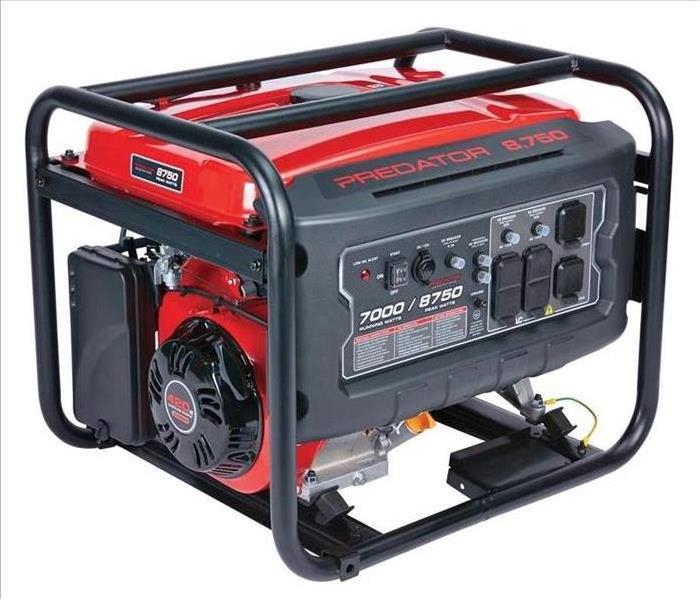Generator Safety After the Storm
9/1/2020 (Permalink)
 It's convenient to run a generator if you lose power after a storm, but you must follow safety guidelines to avoid a CO poisoning tragedy.
It's convenient to run a generator if you lose power after a storm, but you must follow safety guidelines to avoid a CO poisoning tragedy.
Enduring a natural disaster, like a hurricane, tornado, blizzard, flood or other big storm, is bad enough. Even worse is when that disaster leads to tragedy. In August 2020, Laura, a category 4 hurricane, hit the state of Louisiana with winds of 150 miles per hour and a storm surge of up to 15 feet. Hundreds of thousands of people lost power, and subsequently, numerous individuals lost their lives due to carbon monoxide poisoning created by unsafe use of generators.
As reported in The New York Times, “The electrical outages have been deadly, as several people who turned to generators to power refrigerators, lights and air conditioners have been overcome with fumes.
“At least seven people have been killed by carbon monoxide from generators, including four members of a family found dead in a home in Lake Charles. A fifth member of that family was taken to a hospital. Their generator was in a garage and the deadly gas was able to seep into the house through a garage door that was left cracked open, [Lake Charles mayor Nic] Hunter said.
“Another man in Calcasieu Parish, which includes Lake Charles, died of carbon monoxide poisoning from a generator, as did an 84-year-old man and an 80-year-old woman in the same home in Allen Parish, to the northeast, said health officials, who warned people never to place generators in homes or in closed garages.”
The Basics of Generator Safety
Produced by portable generators, carbon monoxide is a colorless, odorless and tasteless gas that can quickly turn deadly. It can take as few as 5 minutes for carbon monoxide to build up to levels high enough to kill, according to the National Institutes of Health.
SERVPRO recommends that you follow these guidelines to safe generator use to prevent CO poisoning.
- Never run a generator in an enclosed space or inside a house. That includes your home’s basement and garage. Most generator-related CO poisoning is caused by generators that are run indoors or in partially enclosed spaces in which deadly levels of carbon monoxide builds up.
- Set up your generator so that it has 3 to 4 feet of clear space on all sides and above. This will allow for enough ventilation to prevent a buildup of CO.
- Locate the generator at least 20 feet from your house. Direct the engine exhaust away from windows and doors.
- Also use a battery-operated carbon monoxide detector when you are running your generator to alert you quickly if CO is accumulating.
- Never run your generator in the rain. Instead, set up a tent or canopy to shield it from the downpour while maintaining good ventilation.
- Immediately leave your house, get to fresh air and seek medical attention if you or others show symptoms of CO poisoning, such as dizziness, headaches, nausea and tiredness. Stay outside until first responders determine your home is free from dangerous CO.
- Consider purchasing a new generator that has a sensor that will detect dangerous levels of CO and automatically shut itself off.
If you have suffered damage from a storm or other disaster at your home or business, call SERVPRO of Bloomfield/Enfield at 860-216-2785
We're Here for You
The team at SERVPRO of Bloomfield/Enfield has specialized training and experience in storm damage restoration, water damage restoration, fire damage restoration, mold remediation, commercial services and natural disaster cleanup. Call SERVPRO of Bloomfield/Enfield at 860-216-2785.
Other Helpful Blog Posts
SERVPRO publishes educational articles on how to protect your home or business from disasters and how to deal with mold, fire, water, sewage, storm and other damage.
SERVPRO of Bloomfield/Enfield
Top 50 Franchise Nationally
100 Peters Road, Bloomfield, CT 06002
IICRC Certified
Noemi Garcia
Certified SERVPRO technicians
Call 860.216.2785
24-hour emergency service
If you have suffered damage from a storm or other disaster at your home or business, call SERVPRO of Bloomfield/Enfield at 860-216-2785






 24/7 Emergency Service
24/7 Emergency Service